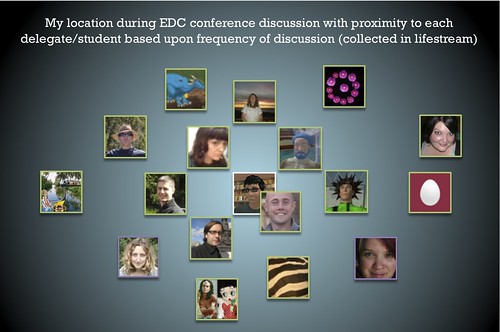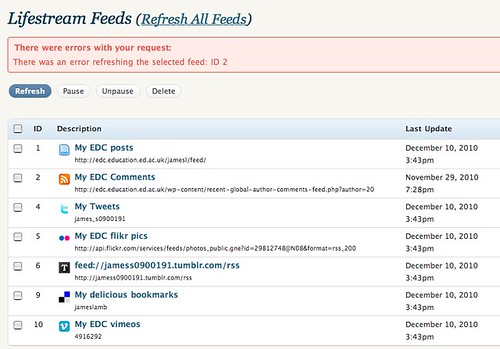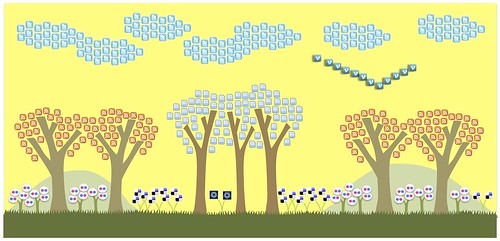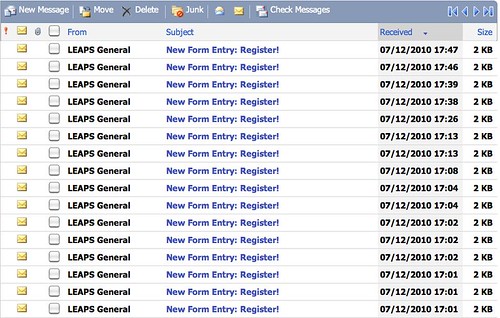My end-of-course lifestream summary
December 12, 2010
I’ve taken the view that the end-of-course lifestream summary offers one more opportunity to creatively explore how ideas might be digitally represented. Although I can hear Carpenter (2009) asking whether this is going to be ’sufficiently academic’, I feel that an exclusively text-based summary would be inconsistent with the approach I have taken over the last 12 weeks. Furthermore, the Course Guide instructions for the summary suggest that:
‘…it should make a reflective statement about what the lifestream demonstrates of your digital activities, and your learning process.’
It seemed appropriate then to share my final reflections using an approach that puts the product of my learning into practice. On occasions within this blog, I’ve likened the lifestream exercise (and digital media in general) to a canvas or sketchbook, the perfect place to develop ideas and to hone one’s powers of expression. In this sense, the lifestream might indeed be seen as embodying the spirit of 17 century common place book, somewhere to construct meaning by gathering words, images and ideas.
In presenting my lifestream summary, I have attempted to borrow both the spirit and the format of the commonplace book. A digital commonplace book.
Rather than offering a text-based reflective commentary of my lifestream, I have attempted to extract images, sounds and passages of text from the lifestream itself. The presentation of my summary, like the content of the lifestream itself, is multi-modal and with different layers of representation.
Finally, everything collected within the scrapbook is my own work. Where original ideas were inspired by others, I have acknowledged their work (with post-its attached to the page). Nevertheless, what you see is an original, personal piece of reflective work.
James’ week 12 and final lifestream review
December 11, 2010
My final week of lifestream feeds doesn’t look as it should.
I’m not talking about a technical problem (although for some reason my comments RSS downed tools on 29 November and can’t be coaxed back to work).
And fauxtography isn’t to blame either.
No, when I suggest it doesn’t look ‘as it should’ I mean that it should probably have reflected preparation for the digital essay assignment. Week 12, after all, was set aside for this purpose. Instead, when I should have been populating my lifestream with essay-focused blogs and delicious bookmarks, I’ve found lots of other avenues to explore.
This though has been the product of ‘meaningful distraction’ rather than procrastination.
It’s fair to say that over the weeks my lifestream has become a place where I’ve expressed ideas that reflect my thoughts on digital culture. It seemed appropriate then that as ideas arose during this final week, I should continue to record them. The blog in particular has become my sketchbook where I can throw ideas down, or share real life experiences, as they happen.
For instance, this week I’ve blogged about the IT Futures conference I’ll contribute towards next week, as well an example from my professional work on the use of SMS messages. I’ve also offered ideas that have appeared whilst giving thought to my 500-word lifestream summary.
If my lifestream can be likened to a gallery, perhaps the content this week might be seen as an exhibition that’s drawing to a close, with time for a few final contributions before artists/visitors make their way to the exit.

Hamburg Bhf art gallery, Berlin. Photographed by s0900191, August 2010
Classroom or conference? My EDC network
December 11, 2010
With a view to the submission tomorrow of my end-of-course summary, I’ve been scanning my lifestream feeds for meaning. One of the questions I keep returning to is , ‘what does my lifestream say about my place in our digital classroom?’
Going back to one of the very earliest posts within this blog, I made an attempt to visually capture what I called ‘the EDC network’. Although the image I created served a purpose at the time (to demonstrate how our classroom isn’t confined by physical boundaries) as a reflection of my place within the class, it has subsequently been rendered inaccurate and incomplete.
My original image implied a single network into which we all imported and exported ideas and inspiration. In reality, the EDC network – or classroom – is made up of a whole series of smaller networks. Networks within The Network, perhaps. For instance, I might be simultaneously engaging in several different threads of discussion, with each conversation conceivably taking place within a different medium.
For instance, over the course of the last twelve weeks my interaction with different members of the class has been uneven. I have engaged in discussion with different members of the class at different times, and as different topics have arisen: Hugh and Marie on the subject of music, Jeremy on animation and film, Dennis on architecture, Martin on technology and teaching, and so on.
I wonder how this compares with the real life classroom? I can only compare this with my experience as an undergraduate, however my tendency then was to work with friends and, within that group, individuals with whom I had a compatible study approach. In the digital classroom however, my collaboration has been more influenced by mutual academic interest.
In the virtual classroom I position myself next to different people from one day to the next, drawn to the benefit I might take from their ideas or how I might contribute to their learning experiences. For instance I spent the earlier part of in the company of Sue and Martin, and latterly, Alison. In essence, ours is a constructionist classroom where we position ourselves in order build knowledge and create collective understanding.
Having said that, my interaction with other members of the group will have been influenced by other factors. I expect that I’m drawn towards people who (online at least) display a personality close to my own (and I presume this would be reciprocated by others)? It’s also important to remember that our engagement with the EDC course doesn’t take place in a vacuum – other ‘outside’ pressures (additional study commitments, professional work, domestic responsibilities) might affect an individual’s ‘attendance’ in the digital classroom and, therefore, the potential for collaboration.
It’s also worth bearing in mind that although the digital classroom might overcome geographical barriers, physical location can still impact upon access to technology and, as we’ve seen in recent weeks, precipitate a meteorological effect that impairs a student’s ability to participate as they might desire.
The fact that I move between different individuals and groups suggests that our digital classroom as a network is flexible and in constant flux. Indeed, I wonder whether instead of drawing comparisons with the relatively static physical classroom, a better metaphor for the EDC community might be seen in the ‘coffee and discussion’ that follows a conference presentation. Delegates mingle with colleagues who they perceive to be of particular value or with whom they share a common professional (or other) bond. The make up of the room constantly changes as delegates move amongst each other, harvesting information and forming small networks that might collectively construct ideas and knowledge.
I was interested to get a sense of where I might be positioned within the EDC ‘conference network’, in relation to my fellow delegates/students. To do this I aggregated the occasions when I had engaged in conversation (through blog comments and Tweets) with each member of the EDC group. Helpfully, this information was available by looking over the content of my lifestream summary. Although this excludes synchronous class discussion and e-mail conversation, I do think this is useful and fairly representative exercise.
Within the diagram below, my proximity to other members of the group is determined by the frequency of interaction we have enjoyed (although due to a problem of ‘lost feeds’ recently, it isn’t entirely accurate).
Where members of the group are on the periphery within my diagram, this is not to say that I haven’t engaged with their ideas or learned from them. Just as it is possible to learn from the conference key note speaker without speaking to him or her directly, so it has been possible to pick up ideas from other members of the class by reading their blogs and so on. Nevertheless, my interaction has been greater, for whatever reason, with those to whom ‘I stand closest’ in the diagram.
However, the birds eye view of the conference discussion that we see here is a snapshot that becomes less accurate with each new conversation-related feed into my lifestream. The make up of a network can rapidly change, for instance as the conference delegate meets someone new who expresses a common interest. In fact the network can cease to exist at all, perhaps influenced by the end of the dedicated coffee and discussion slot, or indeed when the conference itself draws to a close.
Feed problem
December 10, 2010
Hmmm. That’s odd. My EDC Comments haven’t updated since 29 November.
I’ve tried refreshing but an error message appears.
I’m not sure why the comments have stopped updating but everything else is fine?
Any help gladly received. My lifestream review is ‘on hold’ without the missing feeds.
Thanks in advance!
James
The Lifestream Meadow
December 9, 2010
In the early days of the EDC course I pondered (within this blog) whether my lifestream would develop naturally, or whether it might take on a more forced, manufactured form. The former notion quickly proved to be the case, as I observed within a number of weekly lifestream reviews.
Part-way through the course I tried to represent the natural development of my lifestream in visual form, through the use of a tree, with different RSS branches growing out of the trunk.
A few weeks later, I tried to demonstrate within a short animated film, how the lifestream would blossom over the course of a week, each RSS feed representing the opening of a new bud.
The final part of this story concludes with a visual representation of Lifestream Meadow in full bloom.
Within the image, the number of each type of icon is representative of the aggregate number of times that source has fed into my lifestream via RSS. For instance, there are only two Tumblr flowers as I only used Tumblr twice.
Those familiar with Edinburgh might recognise a similarity between Lifestream Meadow and The Meadows, on the southern edge of the University campus. I walk through the Meadows every day on the way to work and, in spring, the trees in bloom are reminiscent of what can be seen in the picture (although much more beautiful, it should be added).
What I’ve captured is only a snapshot of Lifestream Meadow. After all, just a like a real meadow, my lifestream is continually growing and taking on new form. The recent onset of the Scottish winter has left the Meadows bare, therefore it is perhaps appropriate that my lifestream is about to draw to a close.
How I learned to stop worrying and love SMS
December 7, 2010
I thought I’d share this in case anyone already uses, or is interested in using, SMS text bundles as a means of contacting groups of students, colleagues, customers etc
Earlier today, serious expressions were order of the day in the corner of EH8 where my colleagues and I gathered to discuss the Conference for S6 Students we will be staging at Heriot-Watt University in 10 days time. The reason for our uncharacteristic lack of mirth was that, by the start of the day, we had the grand total of 44 conference bookings. This time last year we had topped 350. And we recently booked a bigger venue anticipating even greater turn out this time around.
But seriously, forty four?! As in 44? With just over a week to go?
There were, we acknowledged, mitigating circumstances. It is now 10 days since some of the schools we work with have been open. In fact, all 59 schools have spent more time turning students away from their icy entrances than welcoming them into class over the past week and a half. And so our hard copy fliers – all 2000 of them – are variously sitting in closed schools or delayed in the post. Naturally, we don’t rely solely on the post. The 1600 or so students who provided us with an e-mail in the autumn were sent an e-invitation. But that was the end of last week.
Really? Just forty four? Seriously, I’m worried.
Our final throw of the dice was to send an SMS text message – including a link to our new online booking form – to all the students on our mailbase. We usually engage in this type of communication as a ‘night before reminder’, however with numbers as they were this morning, we could conceivably call on each Conference delegate in person and remind them of the following day’s event. It’s fair to say that my attitude to this type of digital communication has been lukewarm: I can see how it might work, however I haven’t seen conclusive evidence that it makes a real difference. I’ve wanted to believe, however…
And so, Alice Colleague brought the SMS account to life and sent a short message to our potential conference audience. Warm and keen, but not too desperate-sounding. ‘Play it cool boys, real cool’.
The first signs weren’t good. A message instantly popped up telling us that 60 of the students on our mailbase were associated with a mobile number that doesn’t exist. But then digital magic started to happen…
Within the time it took us to log into the e-mail account linked to the online booking form, 16 students had registered. And then the number was 25. By the time we blew the candles out in the office this evening, more students had registered than in the preceding 10 days.
It’s worth stopping to reflect on this for a moment. In the time it took this digital immigrant to log into an e-mail account, 16 students had reached for their phone, opened the text message, clicked on the link (or the equivalent on a lap top) and then completed the online form and submitted their details. A breathtaking example of the digital native at work. And I wouldn’t be suprised if this was done whilst simultaneously having a conversation with a friend, listening to an ipod and other displays of multitasking.
I think there’s another lesson to be taken from this and that’s to avoid making general assumptions about ‘what works best’ in terms of digital communication. Earlier in the EDC course we explored the significance of aptness in the choice of medium to share information with students. What this example shows is that when trying to engage with my target audience of 17-18 year olds at least, text message wins ‘hands down’ over e-mail in terms of grabbing the attention. In factone might conclude that, on this occasion, e-mail has been reduced almost to the point of irrelevance.
What I also think this example shows is the benefit of taking a multimodal approach. Although the text message has grabbed the attention of some students, when schools re-open in the coming days and hard copies of our Conference promo leaflet are passed around, there might be another surge in interest. Perhaps it will require a multimodal approach to help us reach the breadth of audience we desire.
Despite the earlier excitement of seeing online registrations stacking up on screen, our snow covered shoes remain firmly on the ground. After all, we’ve still got some way to go until we reach the number of students who we feel would really benefit from attending our Conference. Furthermore, for all the benefits of taking an apt and multimodal approach, if the snow returns next week, there isn’t much that even the power of SMS can do to save us.
Nevertheless, the expression on this digital immigrant’s face is much more relaxed than first thing this morning.
A quick snapshot of your study space!
December 6, 2010
A big THANK YOU to everyone who completed the Study Space poll that Michael circulated last week as the introduction to our EDCSPACE project. If you haven’t had a chance to share your thoughts it would be great if you could do so (it only takes a minute, I promise!). It has been amusing and interesting to get a sense of where we engage with the course (mostly from the sofa!)
The second of our exercises ties in with a request from Fiona Littleton that you may have seen on the Holyrood Park Hub. Having already collected an idea of where you engage with the EDC course, we’d now like to get a visual picture of your study space.
Full details on how to do this can be accessed here on the EDCSPACE site, however we’re basically looking for an image (or images) of your study space or spaces. You’ll see that Michael and I have already shared our study spaces.
Assuming you’re able to submit a pic, it would be great if you could offer an accompanying statement that (very briefly) explains the pictured space.
In case you were planning to contribute to the project introduced by Fiona, we have her blessing for what we have in mind here and, in order to avoid duplication, would share your image with the wider project (with your approval, naturally).
Do get in touch if you have any questions or experience difficulty sharing your image.
Otherwise, thanks in advance for your valued input. We look forward to seeing your study spaces!
James (and Michael)
(click the button to open the EDCSPACE site in a new window)
Sleeping, eating, blogging: what the frequency of my lifestream feeds says about my engagement with the EDC community
December 6, 2010
Having chosen a mode of presentation for my end-of-course lifestream summary, my thoughts shifted today to what I might include in terms of content. In reviewing my lifestream, I want to go beyond simply outlining what it contains. Instead I would like to reflect on what it ’says’. My mission then has been to try and construct meaning from all the feed icons that populate 11 weeks of lifestream activity.
To begin, I attempted to identify whether there was any pattern in when (within the day) my lifestream activity has taken place and, if so, what this says about my experience as a learner. This is something I attempted fleetingly in my week 3 review, however I was interested to see what this exercise might say when extended across the entire course.
I thus set out to record the time of day allocated to each feed in my lifestream. I appreciate that there can be a delay in some feeds appearing in the lifestream, however my experience has been that, on the whole, messages, blogs and so on appear soon after being posted. As per week 3, I opted to explore fluctuations in activity (at different times of the day) through the use of a short video. On this occassion however, I added captions that account for peaks and troughs in lifestream activity.
http://www.vimeo.com/17523445Although the results are slightly skewed by weekend activity (accounting for an unusual morning peak between 10am and 11am) I think the film suggests there are clear times of the day when I engage in activity that generates feeds. This shouldn’t be confused with a complete picture of when I’m studying – activities such as reading, brainstorming and tutorials don’t generate feeds that appear in the lifestream. Instead, we might see the lifestream as reflecting my engagement with the EDC community. After all, the majority of my activities – tweeting, blogging, posting messages, sharing images – have been concerned with contributing towards collective knowledge creation.
What the video suggests then, is that I have an early morning burst of activity, followed by relative quiet in the working day (other than during my lunch break) before activity really picks up as the end of the day approaches. I find it amusing that my collected lifestream feeds accurately reflect that I am generally making/eating dinner around 6-7pm!
One could conclude from the video that within the online classroom I have the freedom, flexibility and the technological means to dip in and out of conversation during the course of the day. However, the distribution of activity throughout the day (other than during the hours of sleep) suggests than rather than participating within distinct blocks, my immersion in the course is an ongoing thread that runs through the day, with peaks and troughs influenced by competing domestic and professional commitments.
I don’t know whether the clever people at Wordpress have a way of aggregating the timing of feeds for a group (like ours), however it would be fascinating to see how the picture of my own engagement might compare with the group as a whole, or against other individuals. I’m not going to try and second guess what pattern an aggregation of this kind might create, however I expect that we might see an interesting mixture of approaches. After all, the fact that I awake to a series of ‘overnight posts’ or messages – not by any means all attributable to those working in a different timezone – suggests that some members of the class are not prepared to let even sleep disrupt their engagement with the course!
I’m sure that I could construct additional meaning by studying the frequency of my feeds in more depth, however it’s after 6pm and my lifestream tells me I need to be somewhere else…
I’ve been giving some thought to how I might present my lifestream review at the end of this week.
For me, one of the most interesting parts of the EDC course has been the examination of ‘alternative literacies’ and how, in the digital academy, we can present ideas in what might be seen as unconventional – yet apt – formats. Within this blog for instance, I’ve attempted to articulate ideas through animation, film, text and so on.
Assuming it’s appropriate to do so, I plan to present my summary as a form of digital commonplace book (going back to the ancestor of the lifestream). I’ve already tested the water here – my digital ethnography was presented in the form of a scrapbook. I wasn’t completely happy with my finished work on that occasion, so there’s some unfinished business there.
Presenting my lifestream review in the form of a digital commonplace book would allow me to include a mixture of text and image, an appropriate approach considering the dominance of written and visual literacies within the lifestream itself.
Another benefit of taking this route is that, with a strict word count, the inclusion of images might enable me to ’say’ more than might otherwise be possible within 500 words.
Finally, this would give me a final opportunity to experiment before the end of this particular exercise. The lifestream has given me the space to creatively explore new ways of collecting and presenting information – it would be nice to conclude the lifestream in this fashion.
Once more with feeling, then.
James’ Lifestream review: week 11
December 4, 2010
An alternative title to this lifestream review could be A week in the life of a mobile learner.
My lifestream reflects content produced first in Stockholm, followed by London, various locations along the West Coast Rail line and, finally, Edinburgh. And had flight BE8044 not fallen foul of the weather yesterday morning, I would be ending the week posting this lifestream from Hamburg. Mobile learning indeed.
What I think is interesting here is that, had I not commented on my changing location within one or two Tweets, there’s no reason to assume that anyone would be aware of my mobile status this week. As an online learner, one’s geographical location can change without any noticeable impact upon the level of engagement with the course itself, or the learning community of which the student is a member. I’ll give two examples from this week to demonstrate this point.
First, over the last seven days, Michael and I have been partaking in a conversation (using e-mail) that has taken in four countries and three continents. There’s been no let up in discussion as we’ve moved through timezones.
Second, my changing location can’t be detected by any change in the overall level of lifestream activity compared to previous weeks (with content feeding in every day) or the variety of media employed (Flirk, blogging, blog comments, Tweets, Vimeo).
The conversation between Michael and I centred on our common interest in the online learning space as a classroom without walls. My experience this week suggests that the classroom without walls might be populated by mobile learners without a single fixed location.




